Paintings by Shoshannah Brombacher
Exile is punishment; exile is a constant reminder of our fallen status; exile fills us with longings for a permanent home we cannot possess. Paradoxically exile is also where we are most comfortable and where we are most creative with our lives. Exile produced the Talmud, the Zohar, the Rambam and the Shulhan Aruch. Exile, tragically and triumphantly, is still the place of Judaism. The art of Shoshannah Brombacher is a poignant exploration of the art of exile.
Adopting an immediately recognizable exilic style, many of her works have a Chagall-like ambience that perfectly suits her subjects. Chagall was perhaps the most recognizable Jewish artist of the twentieth century who epitomized the Jewish artist in exile; resolutely French in his color and artistic language, deeply Russian in his shtetl images and proudly Jewish in his artistic soul. Much of her work in this manner transforms the Chagall style into a geometrical analysis of exilic themes that she has made very much her own.
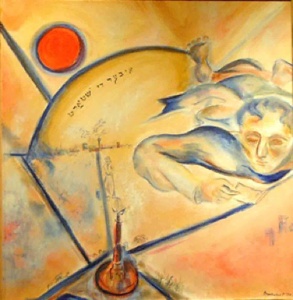
Iber di Shtadt 1 (1994) provides an aerial view the city of Berlin, tracing the route from East to West, from captivity to freedom, that resonates equally with the artist’s sojourn there and the deeply troubled history that is inescapable in every stone, statue and boulevard of the German capital. The angel hovering in the visual foreground adds a poignant tension, reminding us of the kind of divine protection Jews existentially need when they walk the streets of the city that was in all too recent memory, the heart of the beast.
This type of reflection on Jewish history runs through Brombacher’s work, especially evidenced in the ink drawing of The Golem of Prague (1994).
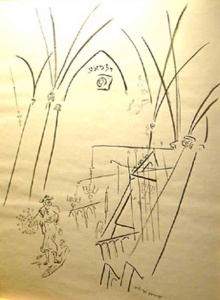
The agitated lines springing from the columns of the ancient Alte Neue Shul in Prague form a musical rhythm echoed throughout the drawing cumulating in the mystical Hebrew letters whirling around Rabbi Loeb. Their beauty seduces us with the magic of the Rabbi’s incantations that will create a living being out of clay until we notice the other letters towering over the scene. Dalet, lamed, mem, alef, ayin, represent the Hebrew of: “Know before Whom you stand.” Indeed we now see this injunction, found inscribed above so many arks, to be a warning not only to be humble but also to curb our attempts at self-defense using extraordinary spiritual means. Perhaps the means of heaven must be left in the hands of heaven.
Many aspects of our experience are just beyond our comprehension, especially the rich prospects of our dreams. Le Songe depicts the dream as another kind of reality, a place of floating embryos in which everything is pregnant with meaning and the possibility of future action. Here the dreamer is encapsulated in the womb of his sleep even as we can see his dream in another circle of light that surrounds a blue horse and tiny rider of his fantasy.
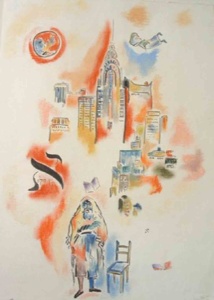
Perhaps the most exciting aspect of this exhibition is when Brombacher confronts exile directly. In what may be her most startling image, Morning Prayers, Adon Olam locates deeply felt religiosity in the very heart of the Big Apple. A traditionally dressed davener, wrapped in talis and tefillin, is seen beneath the Chrysler Building and a jumble of its neighbors. The hustle and bustle of the city is felt in the bold verticals of the structures even as an anomalous flying Chasid careens dangerously close to the famous spire. What is especially innovative about her image is the location of Chasidic spirituality within a modern urban context. This juxtaposition raises the thorny issue of the context and place of prayer; normally thought of as ideally removed from the world; and yet here seen as practiced in the heart of urban and non-Jewish power. The use of color and line indicate that the Jew here is simultaneously independent and yet integrated in this urban New York environment.
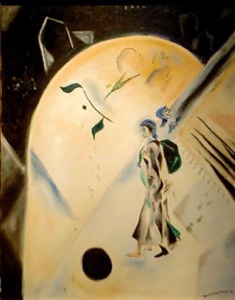
The signature painting in the exhibition is Exile (1994). The image represents a counter-intuitive view of Jewish exile dominated by the gimel of Galut. A female figure stoically marches into the unknown as a tiny male head looks backwards in protest. Suddenly we notice that she subsumes more than one figure as multiple feet emerge under her skirts. In the dark periphery tombstones and graves of a constant past keep a grim watch as they define the light filled shape of exile, defined by the symbols of Yom Tov, especially the lulav and esrog of Succos. Brombacher’s bold shapes of light and dark rearrange our preconception of exile so that we now know that it is a place of spiritual possibility and Jewish life.
But what kind of life is possible here removed from the Land and sovereignty we know is our destiny? Don’t we have a purpose far greater than a few fleeting dreams, the illusion of Jewish strongmen and ignominy of being religious among non-Jews and the irreligious? Brombacher answers with a small simple canvas, Like Zusya done in 1997.
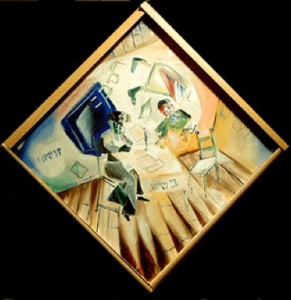
Two Chasidic men are seen at a table. One is sitting pondering his affairs, papers flying about him. The other is more difficult to locate in time and space. First we see his face, surreally half red and half yellow. Then we notice that he is flying with his feet arched above his head. What could this visitation mean with so many Hebrew words and names dancing about the room? Hence the metaphor emerges with the explanatory text; “Reb Zusya of Anipol used to say: ‘After I die they won’t ask me why I wasn’t like Moshe Rabbenu, or like Rambam, or like the Besht, or like other great and famous persons, no, they will ask me why I wasn’t like Zusya.’” And indeed that is exactly our awesome task in galut. To be the most authentic exile Jews we are capable of will surely lead to the exile’s conclusion. If we could but build up the Jewish people through education, understanding and inclusiveness, to prepare ourselves so that as a people we will merit redemption, then exile will evaporate in the flash of our ingathering. Shoshannah Brombacher’s paintings begin to teach us this very difficult art of exile.
Shoshannah Brombacher: Amsterdam, Jerusalem, Berlin, New York
Paintings and Works on Paper